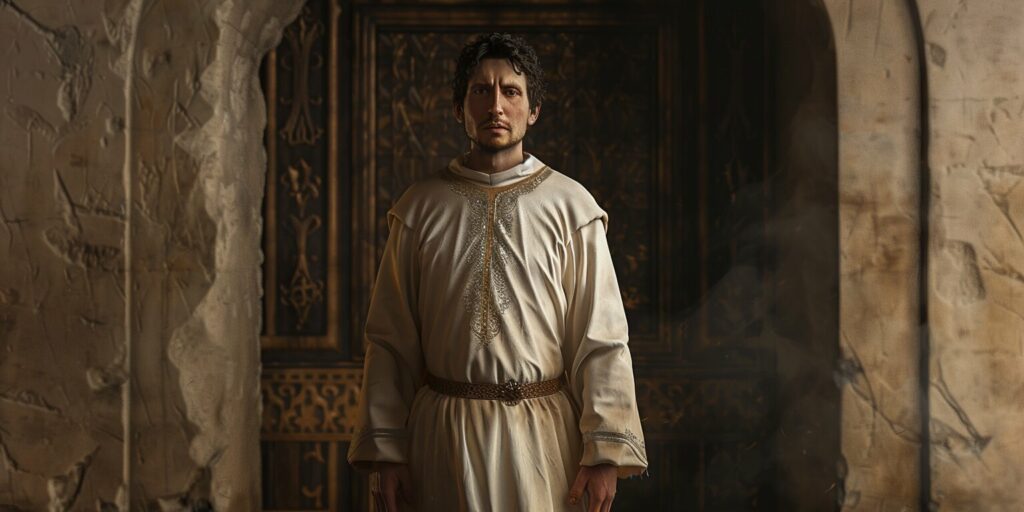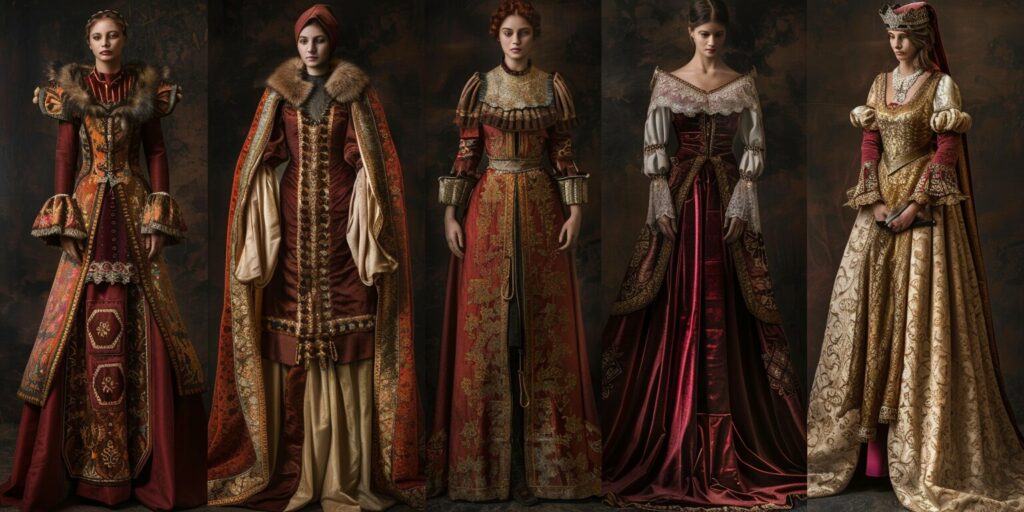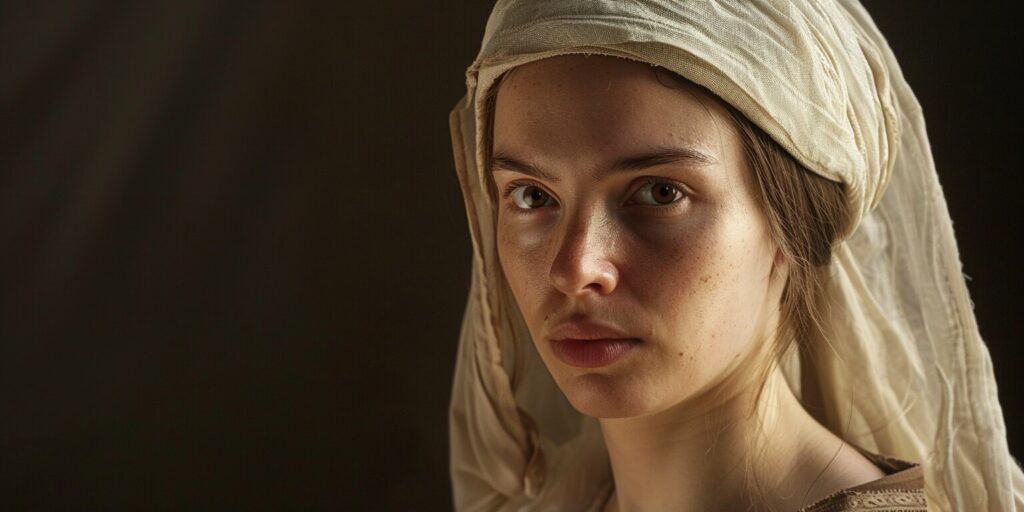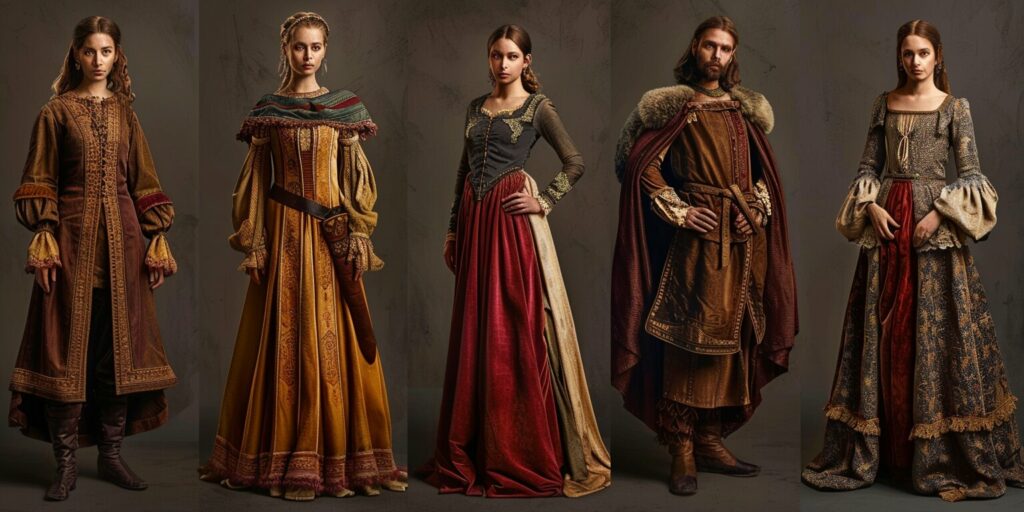Embark on a captivating journey through medieval fashion’s rich and vibrant world. This article takes a deep dive into the clothing styles and trends that defined the look and identity of both men and women during the Middle Ages. From the humble garb of peasants to the opulent robes of nobility, we’ll unravel the tapestry of medieval fashion, uncovering the historical context, social influences, and evolution of clothing across different eras.
By the end of this exploration, readers will have a comprehensive understanding of the key elements, social status impacts, popular accessories, and temporal shifts that shaped the sartorial landscape of the medieval period. Prepare to be captivated by the rich history and fascinating details woven through this transformative era’s medieval clothing, as documented in historical manuscripts. So, if you are curious about medieval women’s clothing history or medieval men’s clothing history, keep reading our article.
What were the Key Elements of Medieval Clothing?
Delving into the core elements that defined medieval fashion, we uncover the fundamental garments, textiles, and regulations that shaped the sartorial landscape of the era. From the ubiquitous tunics and cloaks to the intricate role of wool, silk, and linen, these key elements woven through the fabric of medieval clothing reveal the nuances and complexities of this historical fashion era.
Garments: Understanding the Basic Clothing Pieces
At the heart of medieval fashion history were the basic clothing pieces that adorned the wardrobes of both men and women in medieval England. The tunic, a long, loose-fitting garment that often reached the knees or ankles, was a staple for both genders. Cloaks, versatile outer garments that could be fastened with a brooch or belt, provided warmth and protection. Belts were functional and served as a means of personal expression, with the wealthy adorning theirs with embroidery or precious metals.

Textiles and Materials: The Role of Wool, Silk, and Linen
The choice of textiles and materials played a pivotal role in medieval times fashion, with wool, silk, and linen emerging as the dominant fabrics. Wool, a resilient and versatile fiber, was the most widely used material, particularly among the lower classes. On the other hand, silk was highly prized for its luxurious sheen and soft texture, often reserved for the nobility and upper echelons of society, demonstrating the materials that only the upper class could wear. Linen, a breathable and durable fabric, was also extensively used, especially for undergarments and household linens.
Sumptuary Laws: How Did Regulations Impact Dressing?
The medieval period saw the implementation of sumptuary laws and regulations that restricted the use of certain materials and accessories based on an individual’s social status. These laws were designed to maintain social distinctions, limiting the lower classes from wearing the same expensive fabrics and embellishments as the upper class. The impact of these regulations was far-reaching, shaping the clothing choices and visual representation of different social groups in medieval England.
How Did Social Status Influence Medieval Fashion?
The medieval period was a time when an individual’s social status profoundly influenced their fashion choices. The clothing worn by the nobility and the lower classes often served as a visual representation of their societal position, with the former donning extravagant and opulent attire while the latter was limited to more practical and humble garments.
Noble Attire: The Extravagant Clothing of the Nobility
The nobility in medieval Europe were known for their lavish and ornate clothing, which served as a means to display their wealth, power, and social standing. Nobles often wore gowns, robes, and headdresses adorned with intricate embroidery, lace, and expensive dyes, such as Byzantine-inspired fabrics and fur-lined accessories. These expensive clothing items symbolized their elevated status and were considered a crucial aspect of medieval noble fashion.

Peasant Clothing: Exploring the Simple Attires of the Lower Classes
In contrast to the nobility, the peasants and lower classes in medieval society were limited in their clothing choices, often wearing simple, practical garments made from materials like hemp, wool, and linen. Their clothing was considered along with their social status, with regulations and sumptuary laws restricting the types of fabrics, dyes, and accessories they could use. This distinction in medieval fashion history between the classes was a reflection of the rigid social hierarchy that existed during the 15th century and medieval period, clearly illustrated in the history of costume.
What were the Popular Accessories in Medieval Dressing?
Beyond the fundamental garments that defined medieval times fashion, a myriad of accessories played a crucial role in enhancing individuals’ overall looks and social status during this era. From the intricate embellishments that adorned the cloaks, belts, and outer garments of the nobility to the distinctive head coverings that were an integral part of a woman’s ensemble, these accessories were woven into the fabric of medieval dressing.
Embellishments and Fastenings: The Use of Lace, Embroidery, and Brooches
The medieval aristocracy often showcased their wealth and social standing through the use of lace, embroidery, and brooches on their garments. These decorative elements served to fasten the clothing in place and embroider elaborate designs and patterns that captivated the eye. Brooches, in particular, were a popular accessory that could be worn to secure cloaks and outer garments over the tunic.
Head Coverings: Unveiling the Veils, Bonnets, and Headdresses
For medieval women, head coverings were a crucial aspect of their fashion choices. Veils, bonnets, and headdresses served not only as a means of modesty and social propriety but also as a way to showcase one’s status and wealth in medieval England. Intricate embroidered and laced headdresses were often worn by the nobility, while the lower classes might opt for simpler head coverings that could be tied under the chin.

How Did Fashion Evolve Across Different Medieval Periods?
The medieval times fashion landscape underwent a captivating evolution, shaped by the tumultuous events and cultural shifts that defined each distinct era, particularly noticeable in the 12th century. From the early Middle Ages to the High Middle Ages and the late Middle Ages, the sartorial tapestry of the Middle Ages was constantly being rewoven, reflecting the complex interplay of social, political, and economic factors.
Clothing in the Early Middle Ages: A Glimpse into 5th-10th Centuries Dressing
In the aftermath of the fall of the Roman Empire, the early Middle Ages (5th-10th centuries) witnessed a significant shift in fashion, marking the start of what would be known as clothing in the Middle Ages. The middle Anglo-Saxon era saw a blend of Roman and Germanic influences, with simple yet practical garments like tunics and cloaks becoming the norm. Textiles such as wool, linen, and even animal skins were used extensively, reflecting the utilitarian nature of early medieval clothing.
The High Middle Ages: Fashion Trends in the 11th-13th Centuries
Fashion underwent a remarkable transformation as the 12th and 13th centuries ushered in the high Middle Ages. The influence of the Byzantine Empire and the revival of Roman culture led to a more ornate and elaborate approach to dressing. Clothes were often very expensive, with the nobility adorning themselves in sumptuous fabrics like silk and fine linen, adorned with intricate embroidery and embellishments, as seen in various manuscripts from the 12th century.
Late Medieval Period: Exploring the Clothing Styles of the 14th-15th Centuries
The 14th and 15th centuries, known as the late medieval period, witnessed a further evolution in fashion, including the wider use of fur and elaborate stockings, which have been detailed in the history of costume. The influence of Northern Europe and the beginnings of the Renaissance shaped the sartorial landscape, with clothing styles becoming increasingly tailored and structured. Women’s fashion saw the rise of the headdress, with garments often pulled up to the armpit, while the end of the 14th century marked a shift towards more fitted and streamlined silhouettes.
Conclusion
In conclusion, this article has provided a comprehensive understanding of the rich and diverse world of medieval times fashion. From the basic garments and textiles to the intricate social status influences and the evolution of styles across different eras, we have explored the fascinating tapestry of medieval clothing and the years of fashion. By delving into the key elements, social impacts, popular accessories, and temporal shifts, readers now have a deeper appreciation for the sartorial history of the Middle Ages.
This journey through the woven threads of medieval fashion has unveiled the cultural, societal, and historical significance of clothing during this transformative period. The medieval era witnessed a remarkable diversity in fashion, reflecting the time’s social hierarchy, cultural influences, and technological advancements. From the humble garb of peasants to the opulent robes of nobility, the evolution of medieval fashion tells a captivating story about the values, aspirations, and customs of the people who lived during this captivating era.
As we bid farewell to this exploration of medieval clothing, it’s clear that fashion has always been a powerful tool for self-expression, social stratification, and cultural identity. The intricacies of medieval fashion serve as a testament to the enduring influence of clothing on human civilization. By understanding the past, we can better appreciate the present and envision the future of fashion, forever woven through the tapestry of history and years of fashion.

